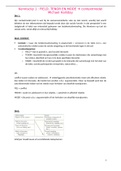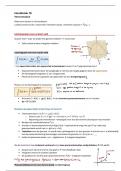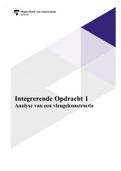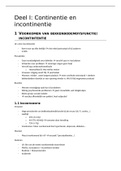Matter:
Anything that occupies space and has mass.
Kinetic Theory of Matter: All matter consists of extremely small particles in constant motion.
Can be solid, liquid or gas.
3 Types of matter:
• Macroscopic - seen with eyes.
• Sub-microscopic/nanoscale - seen with microscope.
• Particulate – imagination
Physical properties
Colour, State of matter, Melting and boiling point, Density, Solubility, Electric conductivity, Malleability, Ductility, Viscosity
• Intensive: do not depend on the amount of substance
• Extensive: do depend on amount of substance
When physical change takes place, composition stays the same.
Chemical properties
Flammability, Toxicity, Oxidizing tendency, Stability.
When chemical change takes place, composition does change.
Signs of reaction:
• Colour change
• Formation of bubbles (gas)
• Odour
Heterogenous Homogenous
Non-uniform composition Uniform composition
Separation methods:
• Density = decanting, centrifugation
• Boiling point = distillation
• Intermolecular forces = chromatography
• Magnetism = magnets
• Solubility = filtration
,Observation types:
• Qualitative = words and description
• Quantitative = measurement with units and numbers
SI Units:
Mass = kilogram, kg
Length = meter, m
Time = second, s
Temperature = kelvin, K
Amount of substance = mole, mol
Electric current = ampere, A
Luminous intensity = candela, cd
Prefixes
Peta- P 1015
Tera- T 1012
Giga- F 109
Mega- M 106
Kilo- k 103
Deci- d 10-1
Centi- c 10-2
Milli- m 10-3
Micro- µ 10-6
Nano- n 10-9
Pico- p 10-12
,Femto- f 10-15
The Angstrom (Å) = 10-10
Errors and Uncertainty:
Accuracy = The agreement of a single measurement with the ’true’ value of the quantity
Precision = the agreement of consecutive measurements with one another
Determinate errors = errors such as:
• Faulty instrumentation
• Sensitivity f instrumentation
• Poor record-keeping
• Assumptions in experimental design
• Judgement errors while reading instruments.
Indeterminate errors = errors that cannot be predetermined such as:
• Environmental factors
• Variations in consecutive measurements under apparently identical conditions
Significant figures:
Burette: 4 sig figs
Measuring cylinder: 3 sig figs
Beaker: 2 sig figs
Significant figure rules:
Addition and subtraction: the answer with the smallest amount of decimal places
Multiplication and Division: final answer with smallest amount of sig figs
Measurements
Area of a Sheet = L X W
Area of a cylinder = π x r2
Volume of cube = L x W x h
Volume of cylinder = π x r2 x h
Volume conversions:
1cm3 = 1ml
1000cm3 = 1dm3 = 1000ml = 1L
1000dm3 = 1m3 = 1000L
, Density:
Intensive property
𝑚𝑎𝑠𝑠
D= = g/cm3 = g/ml = kg/L
𝑣𝑜𝑙𝑢𝑚𝑒
Temperature:
T(K) = …...°C + 273.15
T(°C) = ……K – 273.15
Absolute zero = lowest temperature = 0K = -273.15°C
T(°C) = (…...°F -32)/1.8
T(°F) = 1.8(…...°C) +32










